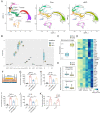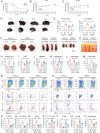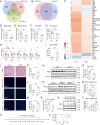The bone-liver interaction modulates immune and hematopoietic function through Pinch-Cxcl12-Mbl2 pathway
- PMID: 38062244
- PMCID: PMC10781991
- DOI: 10.1038/s41418-023-01243-9
The bone-liver interaction modulates immune and hematopoietic function through Pinch-Cxcl12-Mbl2 pathway
Abstract
Mesenchymal stromal cells (MSCs) are used to treat infectious and immune diseases and disorders; however, its mechanism(s) remain incompletely defined. Here we find that bone marrow stromal cells (BMSCs) lacking Pinch1/2 proteins display dramatically reduced ability to suppress lipopolysaccharide (LPS)-induced acute lung injury and dextran sulfate sodium (DSS)-induced inflammatory bowel disease in mice. Prx1-Cre; Pinch1f/f; Pinch2-/- transgenic mice have severe defects in both immune and hematopoietic functions, resulting in premature death, which can be restored by intravenous injection of wild-type BMSCs. Single cell sequencing analyses reveal dramatic alterations in subpopulations of the BMSCs in Pinch mutant mice. Pinch loss in Prx1+ cells blocks differentiation and maturation of hematopoietic cells in the bone marrow and increases production of pro-inflammatory cytokines TNF-α and IL-1β in monocytes. We find that Pinch is critical for expression of Cxcl12 in BMSCs; reduced production of Cxcl12 protein from Pinch-deficient BMSCs reduces expression of the Mbl2 complement in hepatocytes, thus impairing the innate immunity and thereby contributing to infection and death. Administration of recombinant Mbl2 protein restores the lethality induced by Pinch loss in mice. Collectively, we demonstrate that the novel Pinch-Cxcl12-Mbl2 signaling pathway promotes the interactions between bone and liver to modulate immunity and hematopoiesis and may provide a useful therapeutic target for immune and infectious diseases.
© 2023. The Author(s), under exclusive licence to ADMC Associazione Differenziamento e Morte Cellulare.
Conflict of interest statement
The authors declare no competing interests.
Figures







Similar articles
-
LIM domain proteins Pinch1/2 regulate chondrogenesis and bone mass in mice.Bone Res. 2020 Oct 13;8:37. doi: 10.1038/s41413-020-00108-y. eCollection 2020. Bone Res. 2020. PMID: 33083097 Free PMC article.
-
Focal adhesion proteins Pinch1 and Pinch2 regulate bone homeostasis in mice.JCI Insight. 2019 Nov 14;4(22):e131692. doi: 10.1172/jci.insight.131692. JCI Insight. 2019. PMID: 31723057 Free PMC article.
-
Pinch Loss Ameliorates Obesity, Glucose Intolerance, and Fatty Liver by Modulating Adipocyte Apoptosis in Mice.Diabetes. 2021 Nov;70(11):2492-2505. doi: 10.2337/db21-0392. Epub 2021 Aug 11. Diabetes. 2021. PMID: 34380695
-
Stromal cell-derived factor-1 (SDF-1) as a target in liver diseases.Am J Physiol Gastrointest Liver Physiol. 2016 Aug 1;311(2):G203-9. doi: 10.1152/ajpgi.00193.2016. Epub 2016 Jun 16. Am J Physiol Gastrointest Liver Physiol. 2016. PMID: 27313175 Review.
-
BMSCs and hematopoiesis.Immunol Lett. 2015 Dec;168(2):129-35. doi: 10.1016/j.imlet.2015.06.020. Epub 2015 Jul 17. Immunol Lett. 2015. PMID: 26192443 Review.
Cited by
-
Advances in the research of intestinal fungi in Crohn's disease.World J Gastroenterol. 2024 Oct 21;30(39):4318-4323. doi: 10.3748/wjg.v30.i39.4318. World J Gastroenterol. 2024. PMID: 39492826 Free PMC article.
-
Osteocytic vinculin controls bone mass by modulating Mef2c-driven sclerostin expression in mice.Bone Res. 2025 Aug 13;13(1):73. doi: 10.1038/s41413-025-00452-x. Bone Res. 2025. PMID: 40796727 Free PMC article.
-
Bone-derived factors mediate crosstalk between skeletal and extra-skeletal organs.Bone Res. 2025 Apr 30;13(1):49. doi: 10.1038/s41413-025-00424-1. Bone Res. 2025. PMID: 40307216 Free PMC article. Review.
-
Exosome-Mediated Lectin Pathway and Resistin-MIF-AA Metabolism Axis Drive Immune Dysfunction in Immune Thrombocytopenia.Adv Sci (Weinh). 2025 Mar;12(10):e2412378. doi: 10.1002/advs.202412378. Epub 2025 Jan 10. Adv Sci (Weinh). 2025. PMID: 39792656 Free PMC article.
-
Single-atom Zr doped heterojunction enhanced piezocatalysis for implant infection therapy through synergistic metal immunotherapy with sonodynamic and physical puncture.J Nanobiotechnology. 2025 Mar 24;23(1):243. doi: 10.1186/s12951-025-03309-x. J Nanobiotechnology. 2025. PMID: 40128749 Free PMC article.
References
Publication types
MeSH terms
Substances
Grants and funding
LinkOut - more resources
Full Text Sources
Molecular Biology Databases
Miscellaneous

